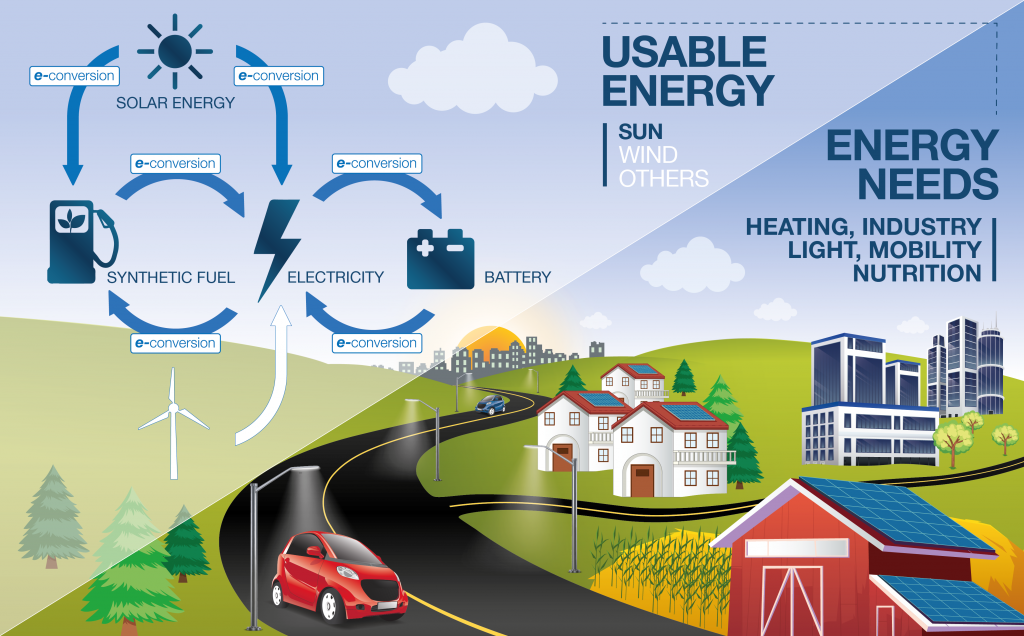
For experts the title and subtitle of our Cluster roll off the tongue. The others are allowed to stumble, and invited to read this article in order to learn what´s it all about. Thereafter the way surely will be open for an easy “Fundamentals of Energy Conversion Processes“…
We don´t know yet how the supply with solely regenerative energy will look like in detail. However, this much is certain: all forms of energy have to be easily convertible into each other. The first process that generally comes to our mind is the direct conversion of sunlight and wind into electricity. However, generated electricity alone will not solve the problem. We need highly efficient storage devices such as batteries, energy carrier like hydrogen for mobility and synthetic fuels with high energy densities for industry and freight transport.
A huge problem is that during every conversion process a considerable proportion of the energy seeps away. Researchers could already reveal the most important “leak”: In nearly every case, the crucial location seems to be at the interface between two materials. There, the potential of energy saving is enormous and a good reason to bring together the best researchers in this field into the e-conversion cluster. But not only the energetically inefficient conversion is worthy of improvement. Many systems lack in stability. Others contain rare and therefore expensive elements such as platinum or iridium, or toxic substances such as lead and cadmium. All these questions are part of the research at e-conversion.

e-conversion investigates the fundamental processes for converting the usable forms of renewable energy into those forms that cover our energy needs.
(Image: Jarno Kott, this graphic has been designed using resources from Freepik.com)
The cluster´s secret of success
The special feature of the DFG Clusters of Excellence is that experts from different areas come together to jointly address a certain question. The researchers at e-conversion are mostly physicists, chemists and biologists with expertise in the fundamentals of photovoltaics, photocatalysis, electrocatalysis, fuel cells, battery research and photosynthesis. The spectrum is supplemented by specialists in optoelectronics – a branch of research that deals with the conversion of light into electrical signals and vice versa. As different as their specific background may be, they all work with related materials and methods and tackle similar problems at the material boundaries.
The core issues for our scientists are the following: What happens at the atomic level and what goes wrong? What can we improve and what kind of alternatives can we develop? May self-designed materials be a key to success? Can one solution also solve challenges of other energy conversion processes? “The problems at the interface between materials lead to critical phenomena like overpotentials, recombination losses and increased resistance,” explains Professor Thomas Bein, one of the three coordinators of e-conversion. “For making progress we first have to analyze the underlying excitation and energy conversion processes at the atomic level. The next step is their optimization.”
Back to basics
As one of the first steps, the scientists construct simplified interface models – in the lab as well as in computer simulations. These models help to understand basic operations in detail and to identify the factors disturbing the conversion process. Thanks to the cluster´s excellent technical facilities the members are able to define the model set-up down to the atomic level and to precisely modify single parameters. Afterwards they test what has to be optimized in the model and later in the more complex working devices. “The resistance in solid-state batteries often is quite high and results from degradation processes at the interfaces,” says cluster coordinator Professor Karsten Reuter. “With simplified models we investigate the atomic processes behind this degradation and analyze how to stop it. As soon as we get valuable results we apply the scheme to real systems.”
Perfectly equipped
In addition to the high-tech instruments in the individual research groups, all members have access to many and partly unique devices and to services of external institutes. This includes the Leibniz Supercomputing Centre and the Research Neutron Source Heinz Maier-Leibnitz at the campus Garching. A close cooperation exists with the soft X-ray synchrotron BESSY II in Berlin. In addition, the TU München is about to build its own Operando Electron Microscopy Center, further invigorating the Cluster. Those microscopes will be able to produce outstanding live records of energy conversion processes in operation at near atomic resolution.
Nevertheless, all these innovative technologies would be nothing without the bright minds behind. The scientists of e-conversion bring in all their knowledge, skills and enthusiasm to help build the sustainable energy supply of the future.
(Author: Birgit Ziller)
